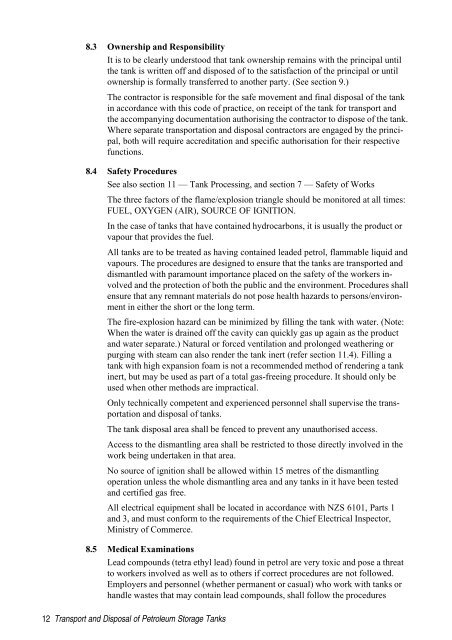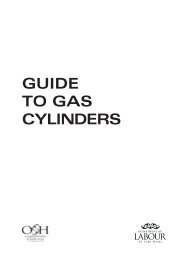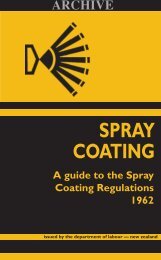Underground Petroleum Storage Tanks and Related Wastes - Code ...
Underground Petroleum Storage Tanks and Related Wastes - Code ...
Underground Petroleum Storage Tanks and Related Wastes - Code ...
Create successful ePaper yourself
Turn your PDF publications into a flip-book with our unique Google optimized e-Paper software.
8.3 Ownership <strong>and</strong> Responsibility<br />
It is to be clearly understood that tank ownership remains with the principal until<br />
the tank is written off <strong>and</strong> disposed of to the satisfaction of the principal or until<br />
ownership is formally transferred to another party. (See section 9.)<br />
The contractor is responsible for the safe movement <strong>and</strong> final disposal of the tank<br />
in accordance with this code of practice, on receipt of the tank for transport <strong>and</strong><br />
the accompanying documentation authorising the contractor to dispose of the tank.<br />
Where separate transportation <strong>and</strong> disposal contractors are engaged by the principal,<br />
both will require accreditation <strong>and</strong> specific authorisation for their respective<br />
functions.<br />
8.4 Safety Procedures<br />
See also section 11 — Tank Processing, <strong>and</strong> section 7 — Safety of Works<br />
The three factors of the flame/explosion triangle should be monitored at all times:<br />
FUEL, OXYGEN (AIR), SOURCE OF IGNITION.<br />
In the case of tanks that have contained hydrocarbons, it is usually the product or<br />
vapour that provides the fuel.<br />
All tanks are to be treated as having contained leaded petrol, flammable liquid <strong>and</strong><br />
vapours. The procedures are designed to ensure that the tanks are transported <strong>and</strong><br />
dismantled with paramount importance placed on the safety of the workers involved<br />
<strong>and</strong> the protection of both the public <strong>and</strong> the environment. Procedures shall<br />
ensure that any remnant materials do not pose health hazards to persons/environment<br />
in either the short or the long term.<br />
The fire-explosion hazard can be minimized by filling the tank with water. (Note:<br />
When the water is drained off the cavity can quickly gas up again as the product<br />
<strong>and</strong> water separate.) Natural or forced ventilation <strong>and</strong> prolonged weathering or<br />
purging with steam can also render the tank inert (refer section 11.4). Filling a<br />
tank with high expansion foam is not a recommended method of rendering a tank<br />
inert, but may be used as part of a total gas-freeing procedure. It should only be<br />
used when other methods are impractical.<br />
Only technically competent <strong>and</strong> experienced personnel shall supervise the transportation<br />
<strong>and</strong> disposal of tanks.<br />
The tank disposal area shall be fenced to prevent any unauthorised access.<br />
Access to the dismantling area shall be restricted to those directly involved in the<br />
work being undertaken in that area.<br />
No source of ignition shall be allowed within 15 metres of the dismantling<br />
operation unless the whole dismantling area <strong>and</strong> any tanks in it have been tested<br />
<strong>and</strong> certified gas free.<br />
All electrical equipment shall be located in accordance with NZS 6101, Parts 1<br />
<strong>and</strong> 3, <strong>and</strong> must conform to the requirements of the Chief Electrical Inspector,<br />
Ministry of Commerce.<br />
8.5 Medical Examinations<br />
Lead compounds (tetra ethyl lead) found in petrol are very toxic <strong>and</strong> pose a threat<br />
to workers involved as well as to others if correct procedures are not followed.<br />
Employers <strong>and</strong> personnel (whether permanent or casual) who work with tanks or<br />
h<strong>and</strong>le wastes that may contain lead compounds, shall follow the procedures<br />
12 Transport <strong>and</strong> Disposal of <strong>Petroleum</strong> <strong>Storage</strong> <strong>Tanks</strong>





